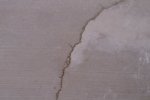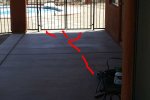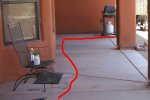While it could be settlement, I believe it is more likely due to concrete shrinkage. Concrete can shrink about 3%. The crack looks like a shrinkage crack to me. Concrete shrinks -- period. There are things that can be done to minimize it, though. A few things that can happen:
- If the mix has a high water/cement ratio (too wet) the conrete will shrink a lot more. A good mix design (not the cheapest one) will have a w/c ratio of maybe .55 at the highest. As a secondary bennefit, this will result in a higher strength concrete as well. This concrete can be harder to place and finish, so many contractors opt for the lower strength, higher shrinkage concrete. This can be OK if other things are done....
- As all concrete shrinks to some degree, even the best concrete will decide to crack in the most visable place. The use of control joints does not prevent the cracks, but encourages them to be in a spot pre-arranged by you. These joints van be trouwled in or saw-cut. The crack will form at the weakest place -- in the joint you created. Use as many of these as you can tolerate.
- reinforcing. No reinforcing steel = cracks. Again, the concrete may crack, but the reinforcing will help these cracks stay small -- or eliminate them if the slab is small enough. If small enough, the reinforcing will help the concrete pull in from all edges instead of crack in the middle. Make sure you have steel in your slab! There are a few types -- welded wire mesh or deformed steel bar (re-bar). The mesh works, but not as well as the re-bar. In a 4" slab, #3 bars at 15" each way is the smallest recommended by code for crack control (0.0018 times the area). The mesh has a hard time achieving this - -especially the smaller mesh most contractors use. Note that the thicker the concrete, the higher the shrinkage stresses and the more reinforcing that is needed.
- placement of reinforcing. The placement of the reinforcing is very important. It's common with mesh to not chair it up on blocks but to try (note 'try') to pull it up to the middle of the concrete slab while the concrete is being poured. I've seen plenty of slabs with the reinforcement in the dirt where it's useless.
- restraint. If the slab can't move when it shrinks, it'll crack in some odd places. If the slab is poured in an 'L' shape around a corner of the house, you can imagine the slab trying to shrink -- and even with the right steel, something's got to break -- and it won't be your house. If the slab is in an odd shape, place it in two pours.
I am specifying a 5" slab with #3 at 12" each way and a w/c of 0.50 and plenty of joints. This is way overkill, but I HATE cracks! :x
Shrinkage cracks typically occur in the first month (usually sooner) after placing the concrete.
As for repair -- a coat of epoxy over the top won't cover the cracks. The cracks should be epoxy injected (not a DIY projcet) which makes the crack go away, but not pretty (you've seen the cracks filled in the floor of your local Home Depot) and then it can be topped. There are products that can top the slab.
Some just tile over the top -- but the crack must be filled first (see above).
If the crack is not sue to shrinkage, but doe to settlement, it'll re-crack. Monitor it for a few months and see if it getts larger. If it's shrinkage, it should do it's thing and stop. If the crack keeps getting larger, it's somehting else.
Steve R




